2017 NISSAN LEAF traction control
[x] Cancel search: traction controlPage 330 of 424
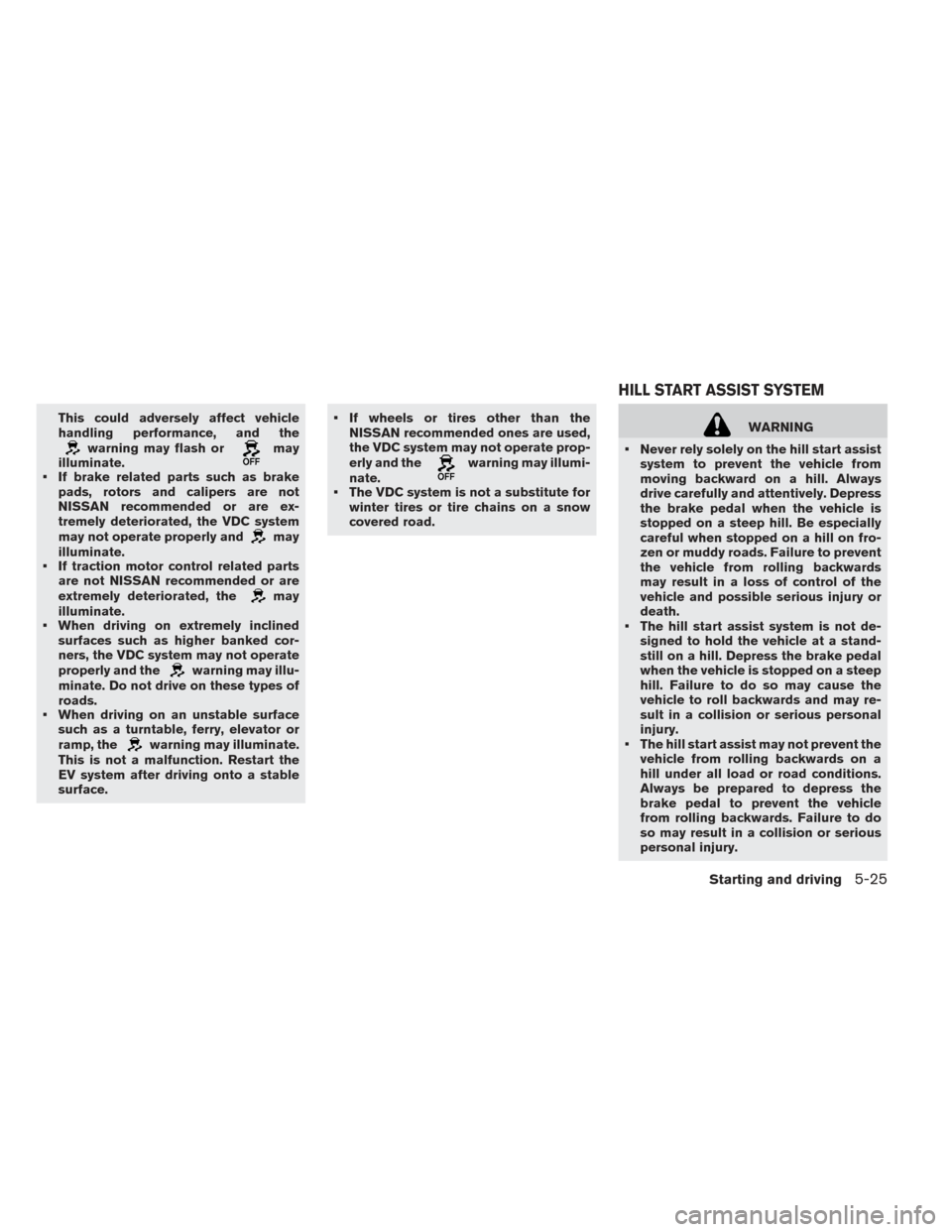
This could adversely affect vehicle
handling performance, and the
warning may flash ormay
illuminate.
• If brake related parts such as brake
pads, rotors and calipers are not
NISSAN recommended or are ex-
tremely deteriorated, the VDC system
may not operate properly and
may
illuminate.
• If traction motor control related parts
are not NISSAN recommended or are
extremely deteriorated, the
may
illuminate.
• When driving on extremely inclined
surfaces such as higher banked cor-
ners, the VDC system may not operate
properly and the
warning may illu-
minate. Do not drive on these types of
roads.
• When driving on an unstable surface
such as a turntable, ferry, elevator or
ramp, the
warning may illuminate.
This is not a malfunction. Restart the
EV system after driving onto a stable
surface. • If wheels or tires other than the
NISSAN recommended ones are used,
the VDC system may not operate prop-
erly and the
warning may illumi-
nate.
• The VDC system is not a substitute for
winter tires or tire chains on a snow
covered road.
WARNING
• Never rely solely on the hill start assist system to prevent the vehicle from
moving backward on a hill. Always
drive carefully and attentively. Depress
the brake pedal when the vehicle is
stopped on a steep hill. Be especially
careful when stopped on a hill on fro-
zen or muddy roads. Failure to prevent
the vehicle from rolling backwards
may result in a loss of control of the
vehicle and possible serious injury or
death.
• The hill start assist system is not de- signed to hold the vehicle at a stand-
still on a hill. Depress the brake pedal
when the vehicle is stopped on a steep
hill. Failure to do so may cause the
vehicle to roll backwards and may re-
sult in a collision or serious personal
injury.
• The hill start assist may not prevent the vehicle from rolling backwards on a
hill under all load or road conditions.
Always be prepared to depress the
brake pedal to prevent the vehicle
from rolling backwards. Failure to do
so may result in a collision or serious
personal injury.
HILL START ASSIST SYSTEM
Starting and driving5-25
Page 333 of 424
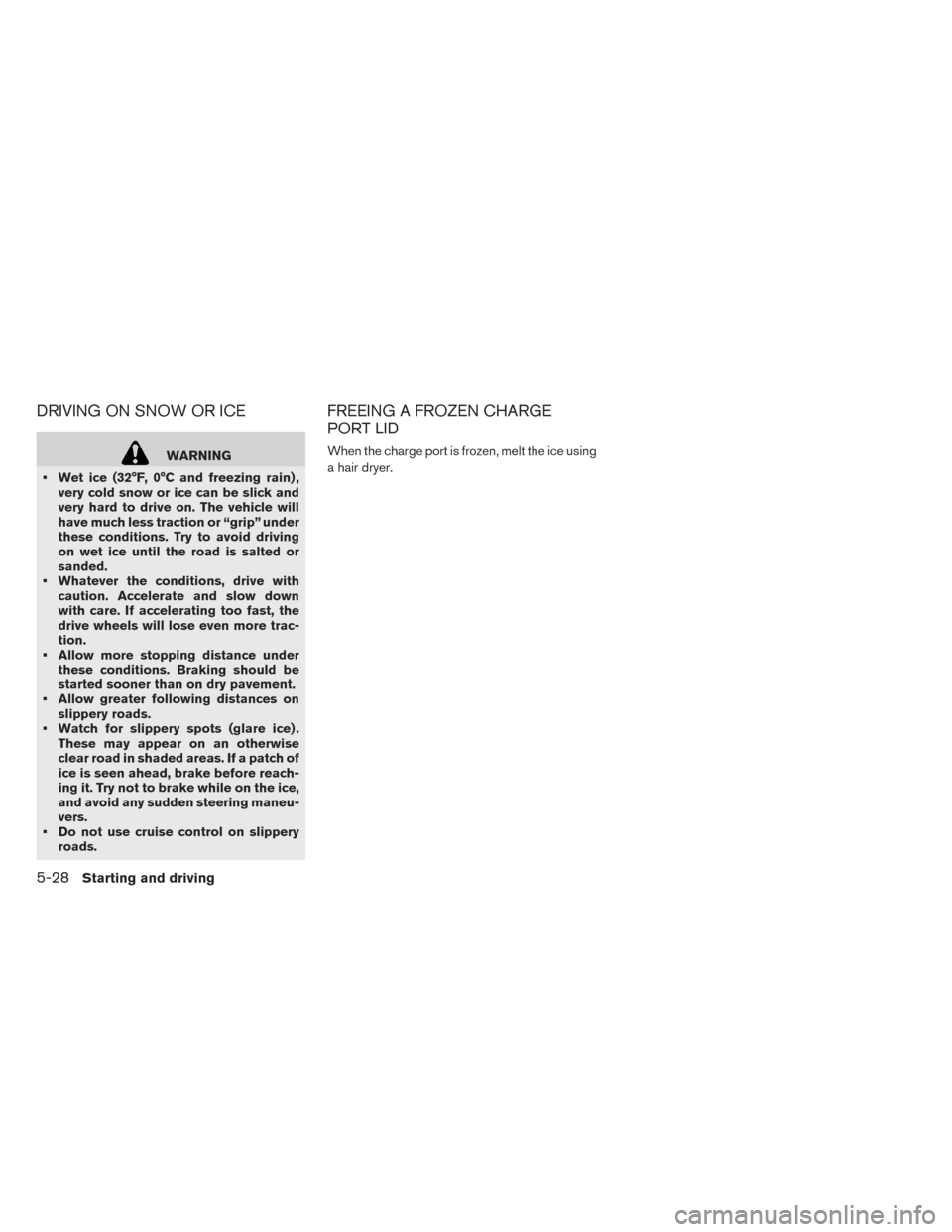
DRIVING ON SNOW OR ICE
WARNING
• Wet ice (32°F, 0°C and freezing rain) , very cold snow or ice can be slick and
very hard to drive on. The vehicle will
have much less traction or “grip” under
these conditions. Try to avoid driving
on wet ice until the road is salted or
sanded.
• Whatever the conditions, drive with caution. Accelerate and slow down
with care. If accelerating too fast, the
drive wheels will lose even more trac-
tion.
• Allow more stopping distance under these conditions. Braking should be
started sooner than on dry pavement.
• Allow greater following distances on slippery roads.
• Watch for slippery spots (glare ice) . These may appear on an otherwise
clear road in shaded areas. If a patch of
ice is seen ahead, brake before reach-
ing it. Try not to brake while on the ice,
and avoid any sudden steering maneu-
vers.
• Do not use cruise control on slippery roads.
FREEING A FROZEN CHARGE
PORT LID
When the charge port is frozen, melt the ice using
a hair dryer.
5-28Starting and driving
Page 394 of 424
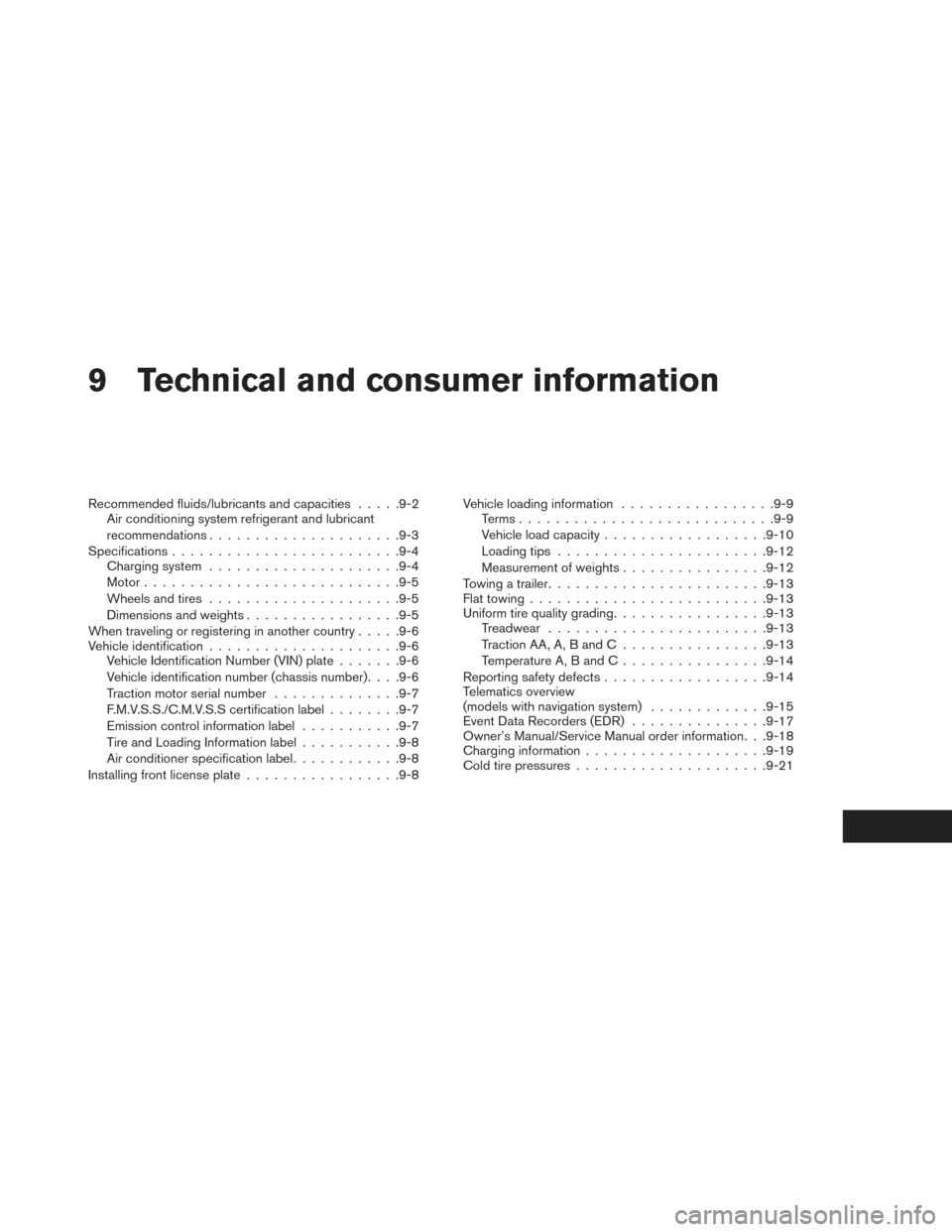
9 Technical and consumer information
Recommended fluids/lubricants and capacities.....9-2
Air conditioning system refrigerant and lubricant
recommendations .................... .9-3
Specifications ........................ .9-4
Charging system .................... .9-4
Motor ........................... .9-5
Wheels and tires .................... .9-5
Dimensions and weights ................ .9-5
When traveling or registering in another country .....9-6
Vehicle identification .................... .9-6
Vehicle Identification Number (VIN) plate .......9-6
Vehicle identification number (chassis number). . . .9-6
Traction motor serial number ..............9-7
F.M.V.S.S./C.M.V.S.S certification label ........9-7
Emission control information label ...........9-7
Tire and Loading Information label ...........9-8
Air conditioner specification label ............9-8
Installing front license plate .................9-8Vehicle loading information
.................9-9
Terms ........................... .9-9
Vehicle load capacity ................. .9-10
Loading tips ...................... .9-12
Measurement of weights ................9-12
Towing a trailer ....................... .9-13
Flat towing ......................... .9-13
Uniform tire quality grading .................9-13
Treadwear ....................... .9-13
Traction AA, A, B and C ................9-13
Temperature A, B and C ................9-14
Reporting safety defects ................. .9-14
Telematics overview
(models with navigation system) .............9-15
Event Data Recorders (EDR) ...............9-17
Owner’s Manual/Service Manual order information. . .9-18
Charging information ................... .9-19
Cold tire pressures .................... .9-21
Page 400 of 424
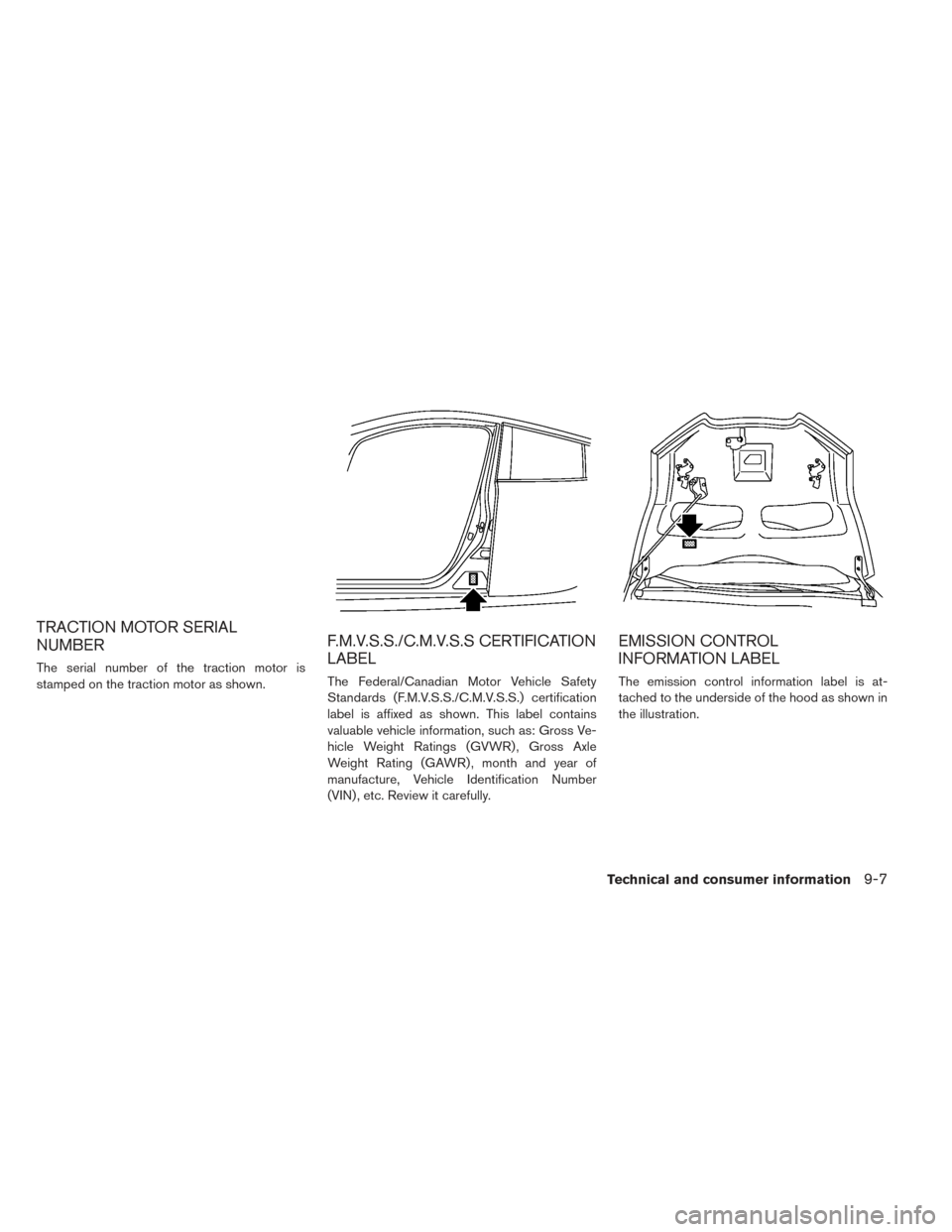
TRACTION MOTOR SERIAL
NUMBER
The serial number of the traction motor is
stamped on the traction motor as shown.
F.M.V.S.S./C.M.V.S.S CERTIFICATION
LABEL
The Federal/Canadian Motor Vehicle Safety
Standards (F.M.V.S.S./C.M.V.S.S.) certification
label is affixed as shown. This label contains
valuable vehicle information, such as: Gross Ve-
hicle Weight Ratings (GVWR) , Gross Axle
Weight Rating (GAWR) , month and year of
manufacture, Vehicle Identification Number
(VIN) , etc. Review it carefully.
EMISSION CONTROL
INFORMATION LABEL
The emission control information label is at-
tached to the underside of the hood as shown in
the illustration.
Technical and consumer information9-7
Page 406 of 424
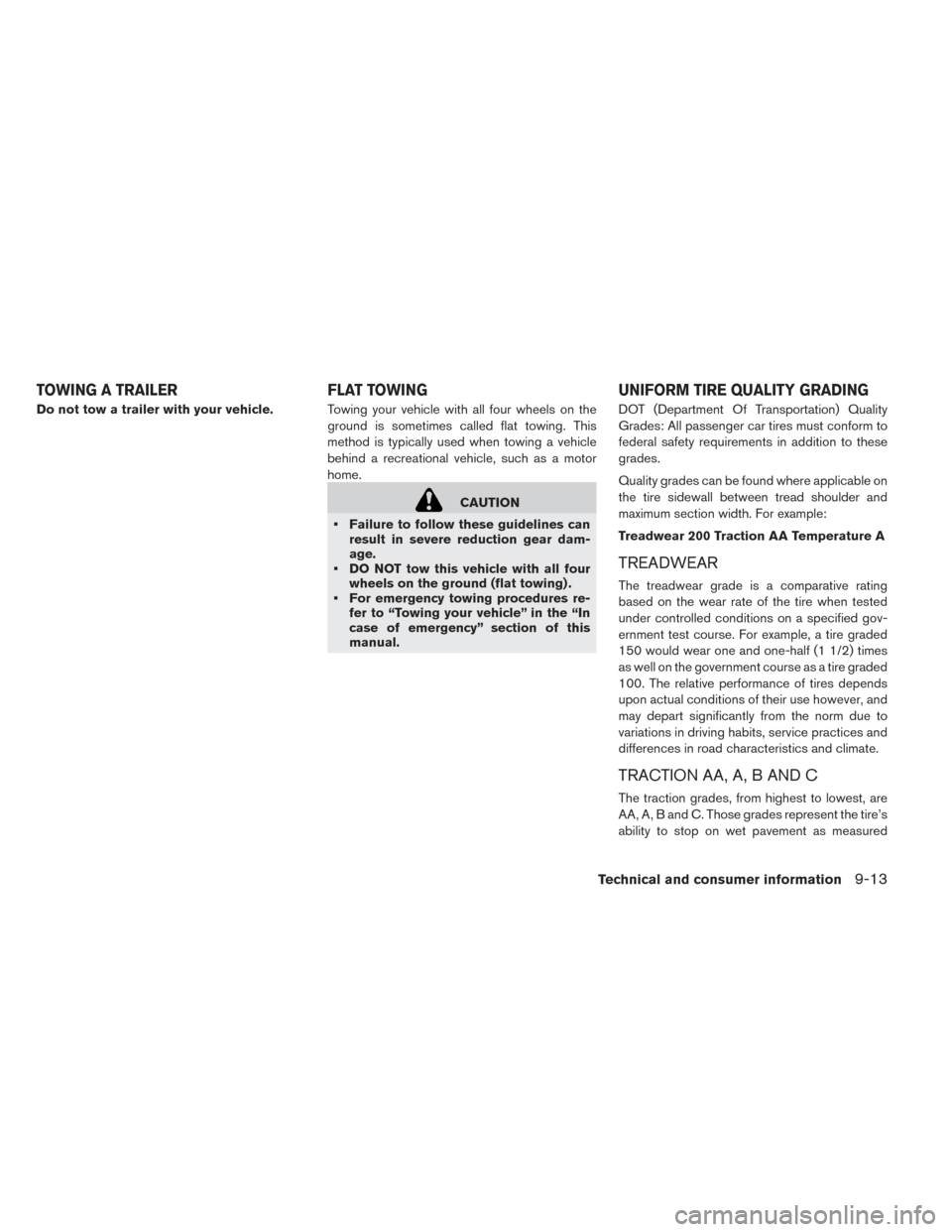
Do not tow a trailer with your vehicle.Towing your vehicle with all four wheels on the
ground is sometimes called flat towing. This
method is typically used when towing a vehicle
behind a recreational vehicle, such as a motor
home.
CAUTION
• Failure to follow these guidelines can result in severe reduction gear dam-
age.
• DO NOT tow this vehicle with all four wheels on the ground (flat towing) .
• For emergency towing procedures re- fer to “Towing your vehicle” in the “In
case of emergency” section of this
manual. DOT (Department Of Transportation) Quality
Grades: All passenger car tires must conform to
federal safety requirements in addition to these
grades.
Quality grades can be found where applicable on
the tire sidewall between tread shoulder and
maximum section width. For example:
Treadwear 200 Traction AA Temperature A
TREADWEAR
The treadwear grade is a comparative rating
based on the wear rate of the tire when tested
under controlled conditions on a specified gov-
ernment test course. For example, a tire graded
150 would wear one and one-half (1 1/2) times
as well on the government course as a tire graded
100. The relative performance of tires depends
upon actual conditions of their use however, and
may depart significantly from the norm due to
variations in driving habits, service practices and
differences in road characteristics and climate.
TRACTION AA, A, B AND C
The traction grades, from highest to lowest, are
AA, A, B and C. Those grades represent the tire’s
ability to stop on wet pavement as measured
TOWING A TRAILER
FLAT TOWINGUNIFORM TIRE QUALITY GRADING
Technical and consumer information9-13
Page 407 of 424
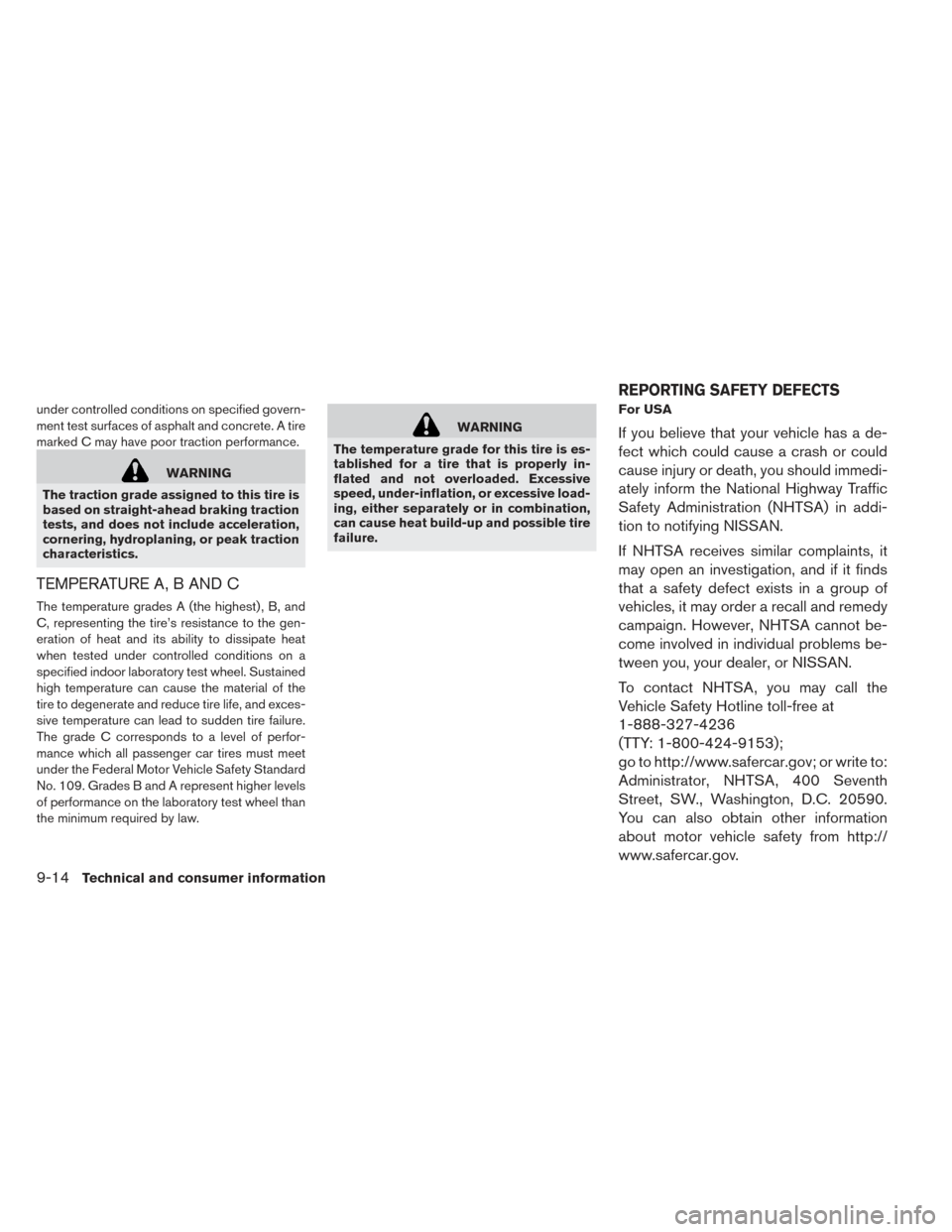
under controlled conditions on specified govern-
ment test surfaces of asphalt and concrete. A tire
marked C may have poor traction performance.
WARNING
The traction grade assigned to this tire is
based on straight-ahead braking traction
tests, and does not include acceleration,
cornering, hydroplaning, or peak traction
characteristics.
TEMPERATURE A, B AND C
The temperature grades A (the highest) , B, and
C, representing the tire’s resistance to the gen-
eration of heat and its ability to dissipate heat
when tested under controlled conditions on a
specified indoor laboratory test wheel. Sustained
high temperature can cause the material of the
tire to degenerate and reduce tire life, and exces-
sive temperature can lead to sudden tire failure.
The grade C corresponds to a level of perfor-
mance which all passenger car tires must meet
under the Federal Motor Vehicle Safety Standard
No. 109. Grades B and A represent higher levels
of performance on the laboratory test wheel than
the minimum required by law.
WARNING
The temperature grade for this tire is es-
tablished for a tire that is properly in-
flated and not overloaded. Excessive
speed, under-inflation, or excessive load-
ing, either separately or in combination,
can cause heat build-up and possible tire
failure. For USAIf you believe that your vehicle has a de-
fect which could cause a crash or could
cause injury or death, you should immedi-
ately inform the National Highway Traffic
Safety Administration (NHTSA) in addi-
tion to notifying NISSAN.
If NHTSA receives similar complaints, it
may open an investigation, and if it finds
that a safety defect exists in a group of
vehicles, it may order a recall and remedy
campaign. However, NHTSA cannot be-
come involved in individual problems be-
tween you, your dealer, or NISSAN.
To contact NHTSA, you may call the
Vehicle Safety Hotline toll-free at
1-888-327-4236
(TTY: 1-800-424-9153);
go to http://www.safercar.gov; or write to:
Administrator, NHTSA, 400 Seventh
Street, SW., Washington, D.C. 20590.
You can also obtain other information
about motor vehicle safety from http://
www.safercar.gov.
REPORTING SAFETY DEFECTS
9-14Technical and consumer information
Page 421 of 424
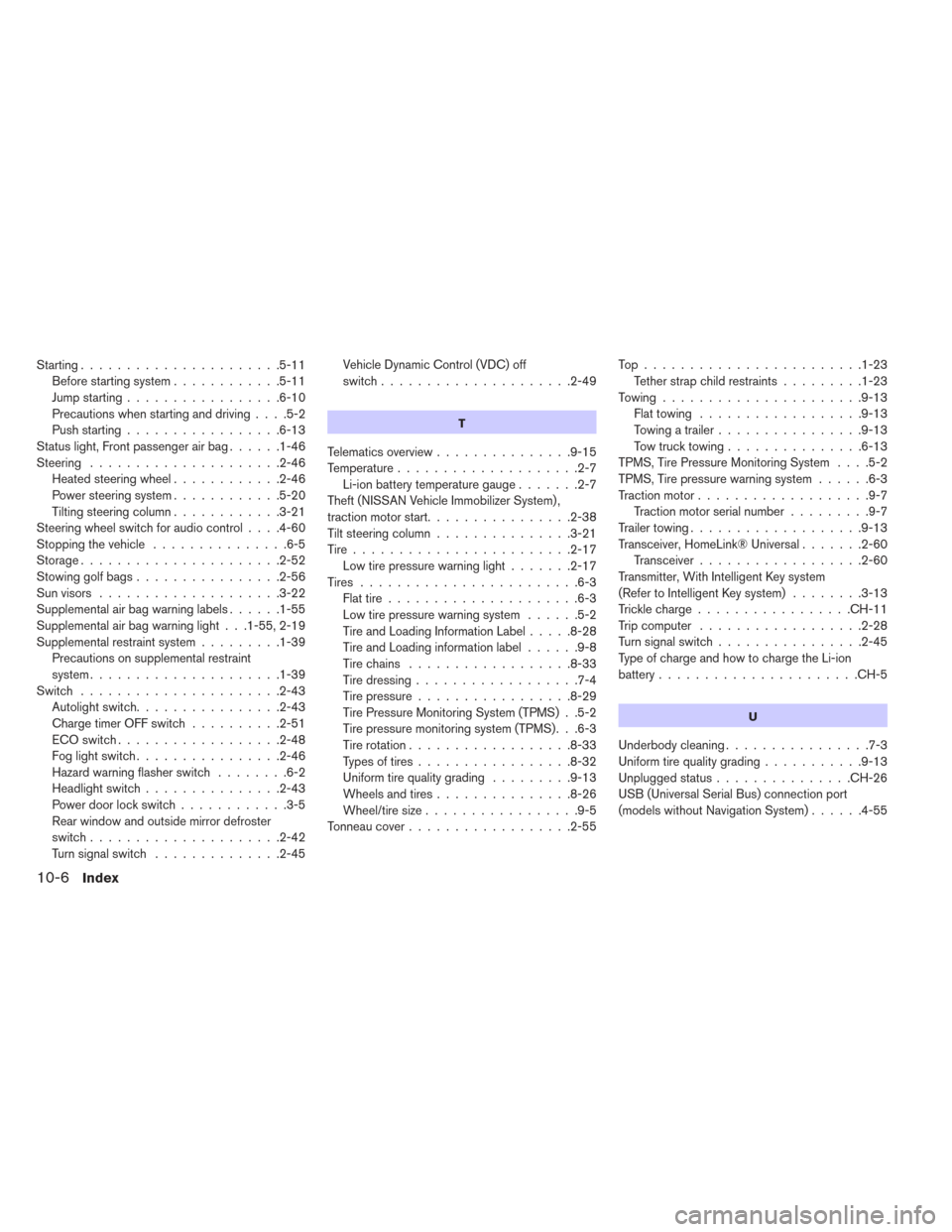
Starting......................5-11
Before starting system ............5-11
Jump starting .................6-10
Precautions when starting and driving ....5-2
Push starting .................6-13
Status light, Front passenger air bag ......1-46
Steering .....................2-46 Heated steering wheel ............2-46
Power steering system ............5-20
Tilting steering column ............3-21
Steering wheel switch for audio control ....4-60
Stoppingthevehicle ...............6-5
Storage......................2-52
Stowing golf bags ................2-56
Sun visors ....................3-22
Supplemental air bag warning labels ......1-55
Supplemental air bag warning light . . .1-55, 2-19
Supplemental restraint system .........1-39
Precautions on supplemental restraint
system.....................1-39
Switch ......................2-43
Autolightswitch................2-43
ChargetimerOFFswitch ..........2-51
ECOswitch..................2-48
Foglightswitch................2-46
Hazard warning flasher switch ........6-2
Headlightswitch...............2-43
Power door lock switch ............3-5
Rear window and outside mirror defroster
switch.....................2-42
Turnsignalswitch ..............2-45 Vehicle Dynamic Control (VDC) off
switch.....................2-49
T
Telematics overview
...............9-15
Temperature ....................2-7
Li-ion battery temperature gauge .......2-7
Theft (NISSAN Vehicle Immobilizer System) ,
traction motor start ................2-38
Tilt steering column ...............3-21
Tire........................2-17 Low tire pressure warning light .......2-17
Tires ........................6-3 Flat tire .....................6-3
Low tire pressure warning system ......5-2
Tire and Loading Information Label .....8-28
Tire and Loading information label ......9-8
Tirechains ..................8-33
Tire dressing ..................7-4
Tire pressure .................8-29
Tire Pressure Monitoring System (TPMS) . .5-2
Tire pressure monitoring system (TPMS). . .6-3
Tire rotation ..................8-33
Types of tires .................8-32
Uniform tire quality grading .........9-13
Wheels and tires ...............8-26
Wheel/tire size .................9-5
Tonneau cover ..................2-55 Top........................1-23
Tether strap child restraints .........1-23
Towing......................9-13 Flattowing ..................9-13
Towing a trailer ................9-13
Towtrucktowing...............6-13
TPMS, Tire Pressure Monitoring System ....5-2
TPMS, Tire pressure warning system ......6-3
Traction motor ...................9-7
Traction motor serial number .........9-7
Trailer towing ...................9-13
Transceiver, HomeLink® Universal .......2-60
Transceiver ..................2-60
Transmitter, With Intelligent Key system
(Refer to Intelligent Key system) ........3-13
Trickle charge .................CH-11
Trip computer ..................2-28
Turn signal switch ................2-45
Type of charge and how to charge the Li-ion
battery ......................CH-5
U
Underbody cleaning ................7-3
Uniform tire quality grading ...........9-13
Unplugged status ...............CH-26
USB (Universal Serial Bus) connection port
(models without Navigation System) ......4-55
10-6Index